“AFTER ALL THE PAIN, IT’S JOYFUL TO GET BACK ON THE ROAD”
It was never Ian Balmforth’s intention to sell his company, but then life changed irrevocably: “I owned a coffee-roasting business. We imported, roasted and supplied the catering market, in addition to our high-end retail coffee brand. My wife was the financial director, but four and half years ago she died suddenly.”
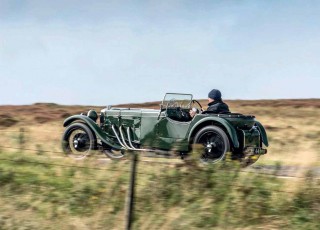
With two teenage daughters to look after, Balmforth sold up to concentrate on raising and supporting them. So how on earth did he end up with a Frazer Nash? “If I’m honest, I’d never heard of them. Bringing up my girls has been a privilege, but I needed something to keep the old grey matter going while they were at school.”
Knowing that his friend Richard Baxter was into cars, they got talking: “I explained that I wanted to buy something, and he said, ‘What about a Frazer Nash?’ And that’s how it began.” Baxter bought Balmforth some instruction at Harewood Hillclimb: “His brother James was an instructor and current vintage-era record holder, as well as a Frazer Nash specialist. He took me out for a drive in the ‘racing driver style’, and half scared me to death – but I loved it!”
Thus hooked, so began the search for a suitable car. “You don’t find them for sale very often. Occasionally, two or three come up, but then you wait ages again,” he explains. Finally, they tracked down a TT Replica at Richard Proctor’s Plus 4 Partnership. It’d once been a special – complete with Ford/Mercury V8 – that competed in the Scottish hillclimb scene during the ’40s and ’50s. It was rebuilt in 1985, when it sold for £13,000, after which it went to the United States.
“I had viewed other examples,” he recalls, “but I loved the look of this one. Even so, I took a risk on it. I trusted the guys who helped me: sometimes you just have to do that. Luckily there’s also a bible by David Thirlby, which has all the genuine cars in it, and you can research chassis and engine numbers, who it was first sold to, etc, and ensure it’s not a bitsa. James Baxter inspected it for me, and it cost an absolute fortune.”
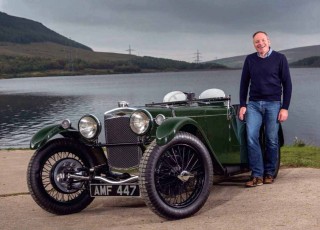
That was the price necessary to gain entry into the Frazer Nash ‘circle’. “I didn’t really understand what that meant,” remembers Balmforth. “It soon became clear, though; it’s a fantastic, thriving car club. There’s so much enthusiasm and knowledge about Archie Frazer Nash and the cars that he produced, including its own archive building in Henley-on-Thames. The Christmas parties are legendary and some of the things they do are incredible. The spares section is great and what you can’t get, there are people who know how to make it, or have it made.”
Having bought the car in January 2015, and spent the first few months getting accustomed, its first event was the driver training and hillclimb at Harewood.
There was, however, a small but growing problem. “It could have been used as it was,” he explains, “but parked next to a real Frazer Nash – and by that, I mean one that looked right – I was a bit disappointed with it.”
The car’s various lives had resulted in aesthetic and mechanical alterations that had left it in limbo: “It had the basics of the correct stuff – engine [4 ED Meadows, but not the original, replaced during the war], chassis, suspension bits, axles, bevel box, etc – but there were details that were wrong. The top of the ’screen was curved, where it should be flat; the exit for the exhaust pipes – there shouldn’t be a slit, just holes; the lights were different; it had stupid wings… the electrics should be Bosch, but there wasn’t one bit on it, and it had a modern clutch. It had oversized carbs and an oil cooler; the engine had an extra support girder that ran through the sump, causing it to leak oil everywhere. People had done all sorts over the years. Finally, it was originally Pearl Green, not two-tone grey.”

As he learnt more and more about marque and model, Balmforth decided that for him originality was key and in future he wanted the TT Rep to compete in the ‘standard’ class. So, in September 2015, he started stripping the car: “I did all the dirty, grungy labouring bits and the overall project management. Ziploc bags and a marker weremyfriends, and when the car was in a thousand pieces in my garage it looked more like a bedstead than an automobile. I did think, ‘I paid all that money for scrap. What do I do now?’”
He explains that there were no fixed timelines, but lots of work going on concurrently; the biggest delays were waiting for things to come back, so the next phase could be started. The engine was stripped down by James Baxter at Tip Top Engineering and the block, crankshaft and sump were sent to specialist Jeremy Brewster for machining, with Haslams in Bolton entrusted with the body. Meanwhile Balmforth set to work on the chassis. “It doesn’t rust,” he says.
“There’s somuchoil in the undertray; the chains are flailing it all over the place. It’s actually one crossmember at the front, two sides and that’s it; not exactly the strongest car in the world, it flexes as you go round corners. There were numerous drill holes for the various engines that had been in it and, although in one respect they were a part of the car’s history, they were welded up. I then primed and painted it.”
One man’s mark, more than most, was ever present: Dr Mirrlees Chassels. He’d bought the car in 1938 for £75 and campaigned it in several events during the following year. The original engine was quickly replaced with another similar one, and then after the war by a Riley 1¼-litre unit. His various hillclimb triumphs – including Bo’ness – were detailed in an August 1949 report in Top Gear, the magazine of the Scottish Sporting Car Club. That also lists later modification to incorporate the fitting of the V8 and, further still, the later addition of twin superchargers. “The power-to-weight ratio must have been immense,” says Balmforth. “He was obviously a very good amateur mechanic – doctor by day, fettler by night. Frazer Nashes have a reputation for snapping chains, and this was exacerbated in the Chassels Special – even the bevel box, which is in essence the gearbox, dropped out once.”
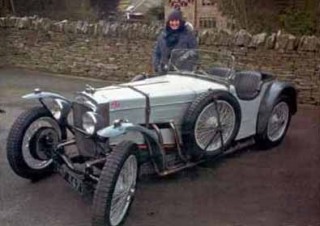
The engine turned out to be the easiest part of the project. Brewster machined a new crankshaft, block and sump, while removing the girder at the same time. James Baxter then rebuilt the unit. “It looks as if it’s never been modified,” says Balmforth. “There’s no gasket between block and sump, it’s just a machined perfect fit. Their combined workmanship is first class; to have a 1933 engine that doesn’t leak is incredible.”
Baxter also fabricated a new standard clutch: “The original design is known for disintegrating and spinning off through the floorboards into fields, but it’s what I wanted. The key is to get it properly aligned – engine perfectly flat, flywheel vertical, lined up to the centre of the car. The old machined-alloy engine mounts were worn, so those were remade – a proper engineering job.”
The bevel box, which transmits drive from propshaft to driveshafts, was also overhauled. There was a problem with the chassis, however. As Baxter and Balmforth refitted the chromed front axle, something wouldn’t mate up; it transpired that it was bent on one side: “James pointed it out and I thought, ‘Oh God.’ This was on the Thursday, and I had the body coming back on Saturday. I don’t like missing deadlines, but luckily a chassis engineer in Bradford fitted it in, straightening it on the Friday.”
Balmforth then re-prepped, re-primed and repainted the chassis, finishing at 2am: “If anyone had asked my girls where I was, they would have said: ‘Oh, he’s in the field grinding!’ I could have left it as it was and bodged it, but it’s so much better to do things right.”
The body refurbishment was a slow process, with bits continually being sent back and forth to Haslams. The rear wheels were too far forward in their arches – “Chassels, probably,” he surmises. So new radius-arm eye bolts were sourced and the wheels moved to their correct position.
With the chassis mated to the body, there was yet more work to do because it didn’t line up: “Haslams did a great job, splicing in new bits of ash frame. They also repaired the factory steel front wings; they were in such a poor state that it cost £1000 to do before they were painted – alloy reproductions would have cost a lot less.
“Colour records are also haphazard. It took a long time to decide, but in the end I went with what I thought appropriate – although it was found by chance: a crusty old tin of BMC Westminster Green in a friend’s dad’s garage.”
Balmforth was particularly satisfied with the tracking down of rare parts: “Bosch electrics; the correct SU carbs were purchased and sent to Burlen for rebuild; I’d never sourced ebony before – it’s amazing what you find when you start looking – and had a local wood-turner machine it for the gearknob. The castings that hold the headlights on, I needed those; through the Frazer Nash Car Club, I found a guy in the Midlands who held the original casting patterns. ‘Do you want them cast in bronze or steel?’ he asked. ‘Bronze, please,’ I replied. ‘I’ve got one in stock, but will have the other made.’ Brilliant. These things come at huge cost – if you want it and someone’s got it, you have to pay.”
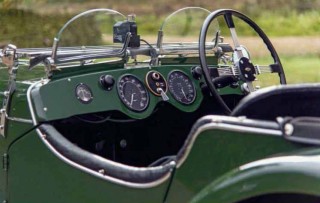
He intended to reassemble the car himself, but was offered a job as director of the group that bought his company. So James Baxter and Tip Top Engineering did the honours. Julian Taylor completed the upholstery, club registrar Winston Teague constructed a new wiring loom and Tony Laws fabricated the bespoke exhaust system. “I’d aimed to complete the project in a year, but finally finished in April 2017,” says Balmforth.
“It’s like doing a house: knock a wall down and find a structural problem; we discovered that the radiator had been modified when the inlet fouled the new crossmember, and again when we tried to fit the bonnet: a two-week delay. Coming from the business world, the time element was the most frustrating thing, but a lot of these skilled craftsmen are one- or two-man businesses and they have to juggle priorities every day.
In the metal, the Frazer Nash doesn’t seem vastly different to a photograph of how it looked before, although that’s only until you get closer. Balmforth takes real pride in pointing out even the smallest detail and discussing the lengths gone to in order to get them correct.
The level of workmanship is superb and that’s reflected in the driving experience. First engages with a distinct crunch, and high-geared it’s good for 40mph; the Meadows unit is smooth and peppy, and your initial disquiet at reaching out of the cabin to shift sprockets soon disappears. There’s a constant thrashing from underneath, as the bevel box works its machinations on the chains. The best bit, though, is the handling, that fixed axle and direct steering allowing you to whip the rear end round – counter-intuitively putting your foot down to tighten the line.
“I love the way it looks now,” says Balmforth, “and the fact that it’s all standard… standard clutch; standard everything; standard driver. But after the pain you go through, it’s simply joyful to get it back on the road. I also have an MGA Twin- Cam, bought restored, that I don’t have anything like the same emotional connection with. When I took the leaf springs apart on this, I uncovered the maker’s name, stamped January 1933. Things like that make you proud of the car.”
So far the TT Rep has competed at Prescott, Harewood, Brooklands and Curborough, but that’s just the start. It’s booked on the Frazer Nash Car Club’s Bolzano 2019 Raid, with 90 cars departing for 10 days’ serious driving in the Alps. “I had several wobbles restoring it,” confesses Balmforth, “but in my circumstances I realise that life can change in an instant, and you really do only live once. I’m very fortunate that, as long as I look after my family, I can spend some money on cars, and there’s something about a Frazer Nash that just gets you.”
Clockwise: a delighted Balmforth; correct holes for exhausts rather than a slit; rebuilt Meadows with the right SUs; bronze lamp mounts sourced via club.
Plain but supremely functional cabin, with big rev counter that reads to 6000rpm – no redline – ahead of driver, and lovely four-spoke sprung wheel.
Tiny, lightweight TT Rep is in its element on backroads with its chuckable, tail-happy handling. Note flat-topped windscreen; it was curved pre-resto.
“THE CLUTCH IS KNOWN FOR SPINNING INTO THE FIELDS, BUT THE KEY IS TO ALIGN IT PROPERLY”
“IN A THOUSAND BITS IN MY GARAGE, IT LOOKED MORE LIKE A BEDSTEAD THAN AN AUTOMOBILE”
Work in progress
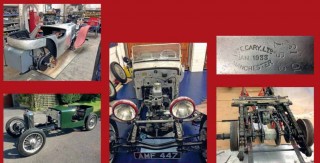
Maker’s name revealed on dismantled leaf spring. Rebuilt bevel box (centre) with famed ‘chain gang’. Overhauled Meadows 4 ED reunited with chassis. Haslams exactingly restored factory front wings. Chance find prompted Westminster Green choice.





